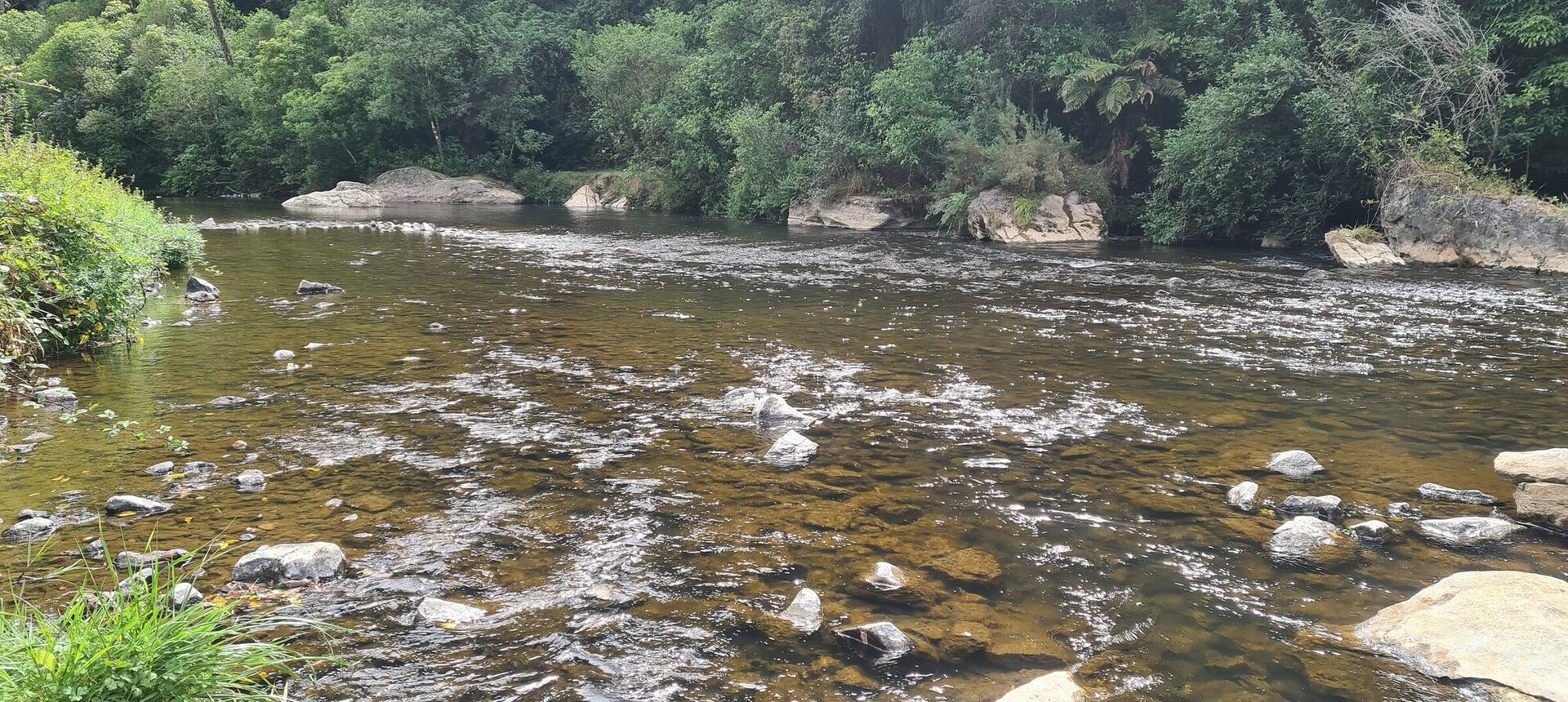2024 Quarterly results
August 2024
Water quality was Good to Fair. E. coli and dissolved inorganic nitrogen were elevated at one site and water clarity was poor at two sites.
E. coli concentrations were low at three sites (≤ 170) and slightly elevated at 38-Mangatangi stream (430). All sites fell within recommended health limits for swimming (540). Nitrate concentrations were low at all sites, falling well below ecological toxicity impacts (2.4 mg/L). Nitrates were lowest at 37-Oteke stream (0.38 mg/L) and highest at 38-Mangatangi stream (0.57 mg/L). Ammonia concentrations were exceptionally low at 3 sites (≤ 0.005 mg/L) and highest at 36-Puaroa Stream (0.04 mg/L). Dissolved inorganic nitrogen (DIN) was low at all but one site, 38-Mangatangi Stream (0.57 mg/L), where concentrations fell just above concentrations which can cause ecological impacts. DIN concentrations greater than 0.5 mg/L can cause ecological impacts like excessive growth of algae and aquatic plants, and loss of sensitive species. Dissolved reactive phosphorus concentrations were low at all sites (≤ 0.008 mg/L) but were highest at 38-Mangatangi Stream (0.008 mg/L). Water clarity was excellent at two sites, 36-Puaroa stream and 37-Oteke stream. Water clarity was poor at 35-Ngāhuinga stream and 38-Mangatangi Stream, relative to the national bottom line (0.61 cm).
Sample Collection Day: 22th August 2024

May 2024
Water quality was Excellent, except for E. coli which was slightly elevated at one site.
E. coli concentrations were low at three sites (≤ 150) and slightly elevated at 35-Nghuinga stream (360). All sites fell within recommended health limits for swimming (540). Nitrate concentrations were low at all sites, falling well below ecological toxicity impacts (2.4 mg/L). Nitrates were lowest at 36-Puaroa stream (0.23 mg/L) and highest at 38-Mangatangi stream (0.49 mg/L). Ammonia concentrations were exceptionally low at all sites (≤ 0.005 mg/L). Dissolved inorganic nitrogen was low at all sites (≤ 0.49), however, site 38-Mangatangi stream fell just above concentrations which can cause ecological impacts (0.5 mg/L) like problematic growth of algae and aquatic plants, and the loss of sensitive species. Dissolved reactive phosphorus concentrations were low at all sites (≤ 0.01 mg/L) and were highest at 38-Mangatangi Stream (0.01 mg/L). Water clarity was excellent at all sites, relative to the national bottom line (0.61 m). 37-Oteke stream had the highest water clarity (2.63 m).
Collection date: 13th May 2024

February 2024
Water quality was Good, except for E. coli and dissolved reactive phosphorus, with each being slightly elevated at two separate sites.
E. coli concentrations were low at three sites (≤ 170) and slightly elevated at 36-Puaroa stream (320). All sites fell within recommended health limits for swimming (540). Nitrate concentrations were low at all sites, falling well below levels where ecological toxicity impacts can occur (2.4 mg/L). Nitrates concentrations were lowest at 37-Oteke Stream (0.06 mg/L) and highest at 35-Nghuinga Stream (0.14 mg/L). Ammonia concentrations were exceptionally low at all sites (≤ 0.009 mg/L). Dissolved inorganic nitrogen was very low at all sites (≤ 0.14), falling well below concentrations which can cause ecological impacts (0.5 mg/L) like problematic growth of algae and aquatic plants, and the loss of sensitive species. Dissolved reactive phosphorus concentrations were exceptionally low at all 3 sites (≤ 0.004 mg/L) but were slightly elevated at 38-Mangatangi Stream (0.011 mg/L). Water clarity was excellent at all sites, relative to the national bottom line (0.61 m). 37-Oteke stream had the highest water clarity (2.94 m).
Sample collection day: 14th Feburary 2024

2023 Summary
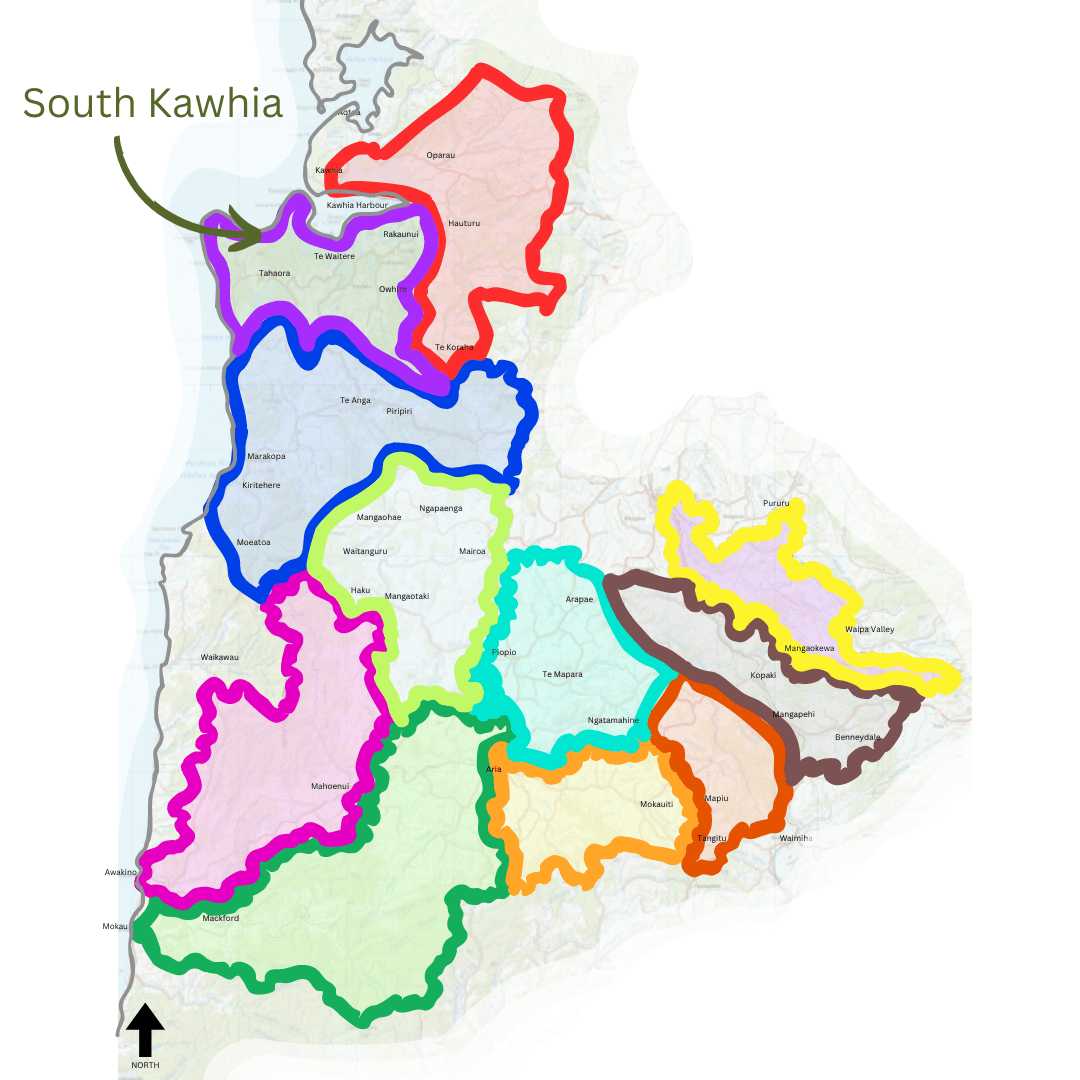
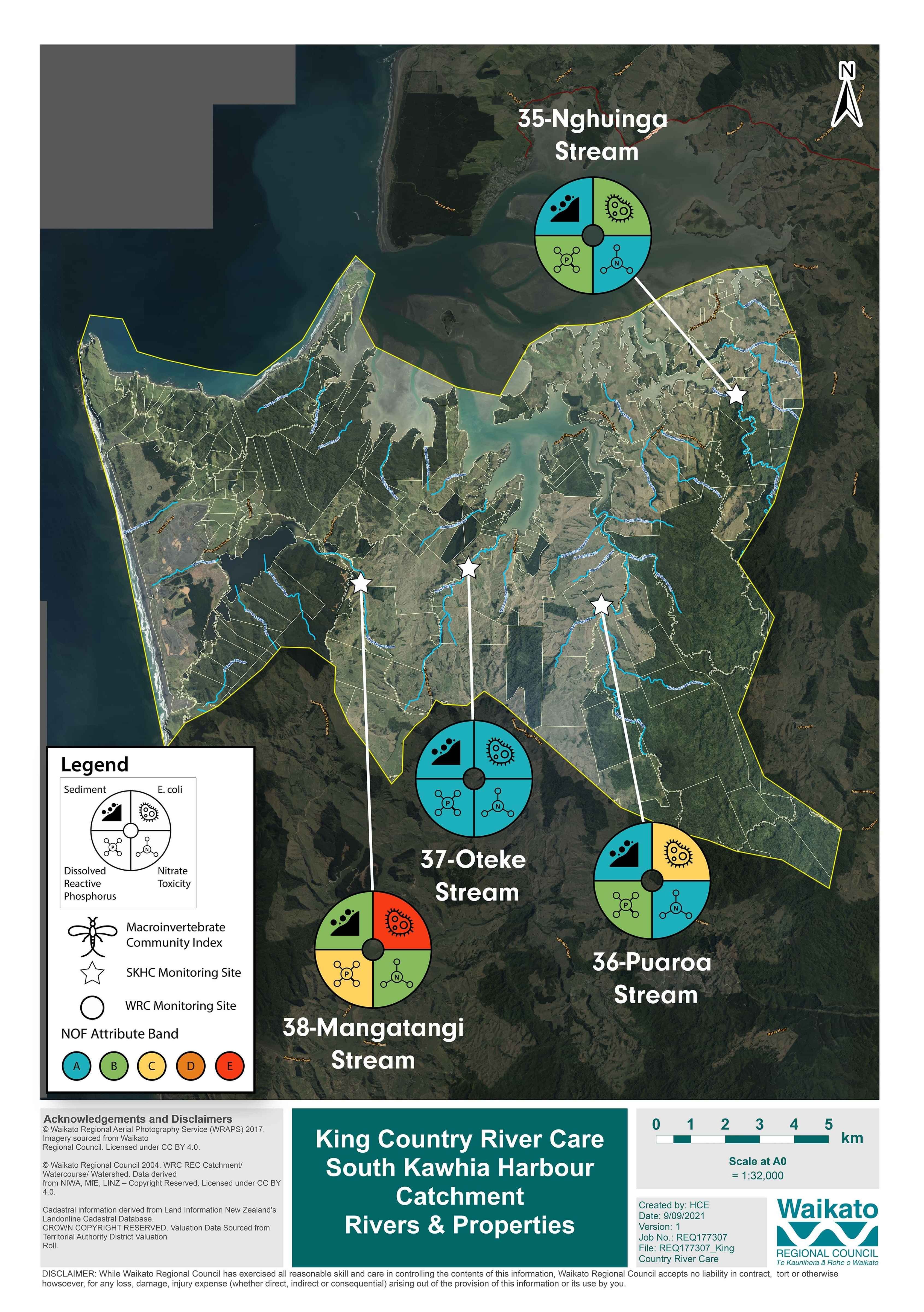
Water samples were collected from 4 stream or river sites across the South Kawhia catchment in 2023. The sites are located on Ngāhuinga stream, Puaroa stream, Oteke stream and Mangatangi stream (all sampled quarterly).
The below water quality dial for South Kawhia represents 16 individual samples and summaries the monitoring results from these 4 locations, collected between January 2023 – December 2023.
E. coli was slightly elevated which may pose a risk to human health from swimming. Nitrogen, dissolved reactive phosphorus (DRP) and suspended sediment were low, which supports ecosystem health. All attributes met national water quality limits.
Arrows indicate an increase or decrease in values compared to the baseline for Kawhia. No arrows indicate where there’s no deviation from baseline values. The baseline was calculated from 5 years of data collected by the council at the Oparau river monitoring site, between 2016 – 2020. An increase in water clarity is positive for river health, while an increase in all other attributes may impair river health.
South Kawhia Dial, 2023
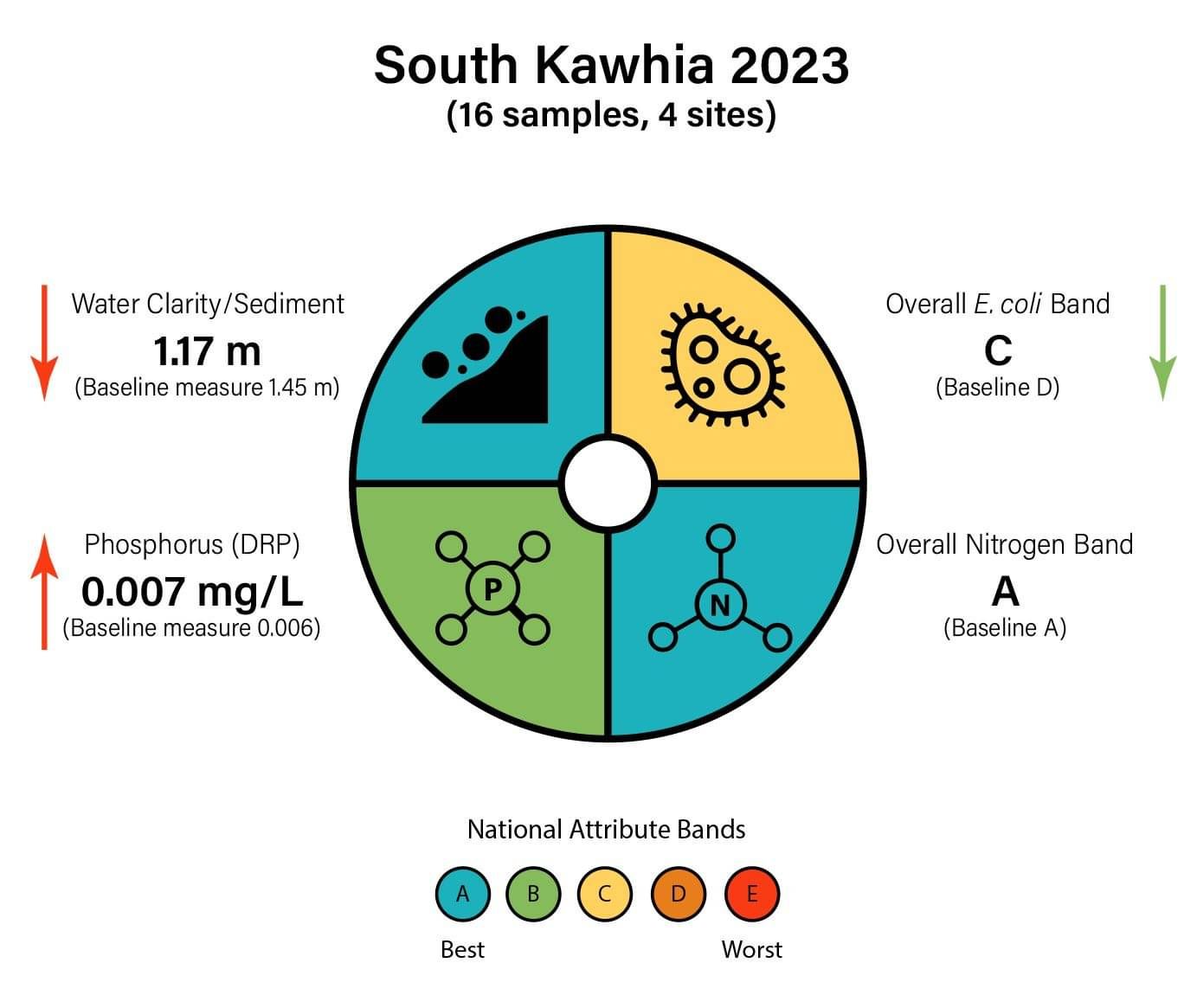
Aquatic Biodiversity Summary
Biodiversity monitoring includes eDNA, collected by KCRC, and traditional biodiversity monitoring techniques (netting of freshwater invertebrates and netting and electrofishing of freshwater fish), by Waikato Regional Council (WRC). eDNA sampling has been done by KCRC, in autumn and winter in 2021, 2022 and 2023. WRC monitors most sites every 1 to 2 years, between November and March. If more than one results is available for any single monitoring location the results for that site are averaged across years.
Both North and South Kāwhia have significant freshwater biodiversity value, however, some sites are showing early signs of ecological stress.
Just under halve of freshwater invertebrate MCI scores are good.
The number of insect species detected from eDNA (an indicator for ecological health) were low in Te Kauri stream (North Kāwhia), 17 species and moderate in Puaroa stream (South Kāwhia), 39 species.
Fish communities were diverse across north and south Kāwhia.
Three whitebait species were detected, Giant kōkopu, Banded kōkopu and inanga.
Six species of threatened fish present, including lamprey, Īnanga, Giant kōkopu, Longfin eel, Redfin bully and Torrentfish.
Only 1 species of introduced fish was detected, brown trout.
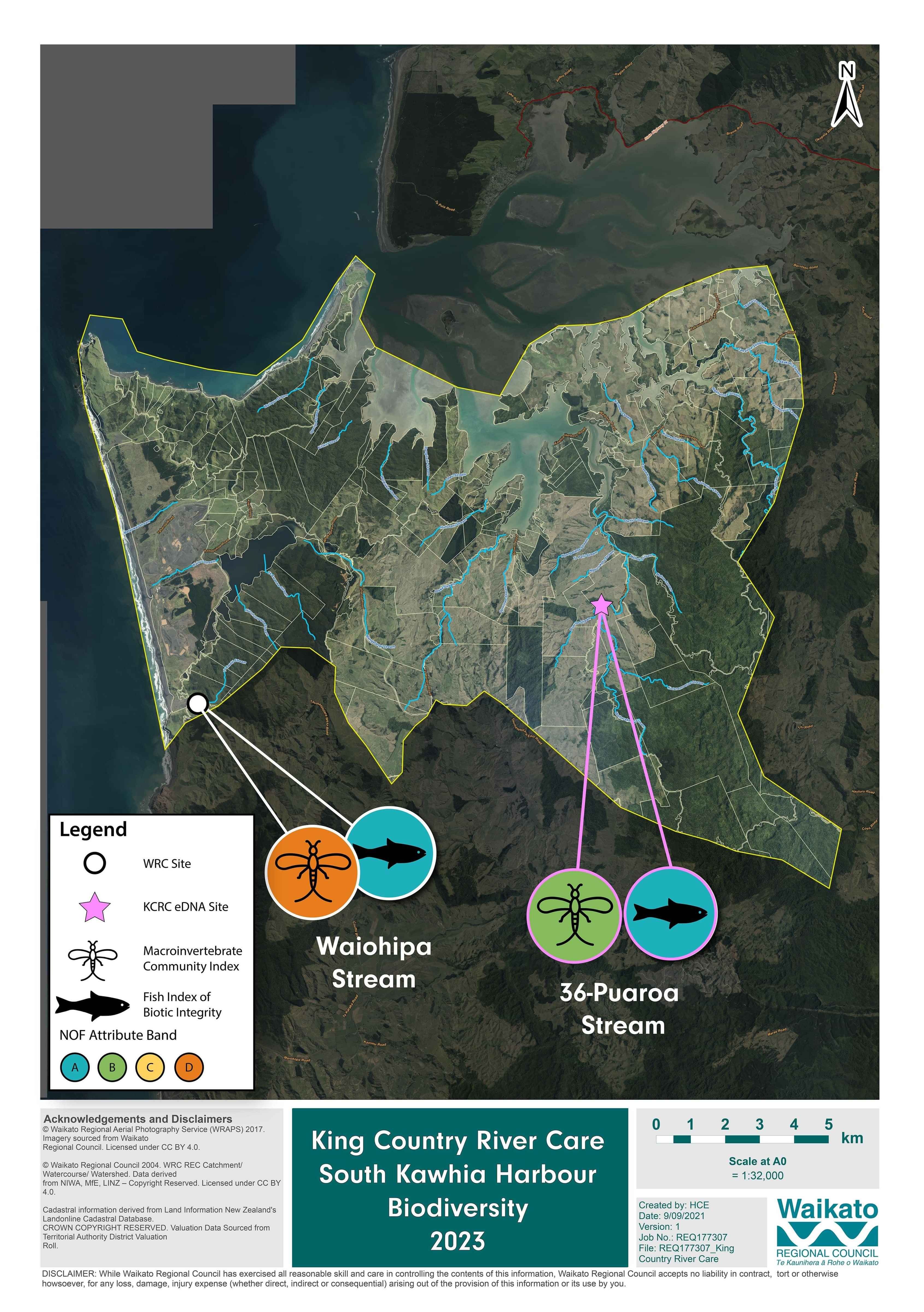
2023 Quarterly results
November 2023
Water quality was excellent at all four sites. E. coli concentrations were very low all sites (≤ 190). Nitrate concentrations were well below toxicity levels at all sites being lowest at 36-Puaroa Stream (0.11 mg/L) and highest at 38-Mangatangi Stream (0.20 mg/L). Ammonia concentrations were exceptionally low at all sites (≤ 0.007 mg/L). The combined concentration of Nitrate + Ammonia was below 0.5 mg/L at all sites. Ecological impacts, including problematic growth of algae and/or aquatic plants and loss of sensitive aquatic invertebrates may occur when the combined concentration of nitrate and ammonia regularly exceed 0.5 mg/L. Dissolved reactive phosphorus concentrations were exceptionally low at all 4 sites (≤ 0.005 mg/L). Water clarity was excellent at all sites relative to the national bottom line (0.61 m). 37-Oteke Stream had the highest water clarity (2.45 m) and 35-Nghuinga Stream had the lowest (1.61 m).
Collection date: 10 November 2023

August 2023
Overall water quality was good at 3 out of 4 sites. 38-Mangaohuinga Stream showed signs of impact indicated by higher concentrations of E. coli and dissolved reactive phosphorus. E. coli concentrations were very low at 3 out of 4 sites (≤ 87) and elevated at 38-Mangaohuinga Stream (660). Nitrate concentrations were below toxicity levels at all sites being lowest at 35-Nghuinga Stream (0.37 mg/L) and highest at 38-Mangaohuinga Stream (0.78 mg/L). Ammonia concentrations were low at all sites (≤ 0.009 mg/L). 38-Mangaohuinga Stream had a combined concentration of Nitrate + Ammonia equivalent to 0.79 mg/L. Ecological impacts, including problematic growth of algae and/or aquatic plants and loss of sensitive aquatic invertebrates may occur when the combined concentration of nitrate and ammonia regularly exceed 0.5 mg/L. Dissolved reactive phosphorus concentrations were low at 3 out of 4 sites (≤ 0.008 mg/L) and elevated at 38- Mangaohuinga Stream (0.012 mg/L). Water clarity was good at all sites relative to the national bottom line (0.61 m). 37-Oteke Stream had the highest water clarity (1.39 m) and lowest at 38-Mangatangi Stream (0.80 m).
Sample collection day: 25 August 2023

May 2023
E. coli concentrations were low at 3 out of 4 sites and elevated at 38-Mangatangi Stream (730). Nitrate concentrations were below toxicity levels at all sites being lowest at 36-Puaroa Str-Owhiro valley (0.33 mg/L) and highest at 38-Mangatangi Stream (0.78 mg/L). Ammonia concentrations were exceptionally low at all sites (≤ 0.005 mg/L). 38-Mangatangi Stream had a combined concentration of Nitrate and Ammonia exceeding 0.5 mg/L. Ecological impacts, including problematic growth of algae and/or aquatic plants and loss of sensitive aquatic species are likely when the combined concentration of nitrate and ammonia regularly exceed 0.5 mg/L. Dissolved reactive phosphorus concentrations were exceptionally low at 3 out of 4 sites (≤ 0.007 mg/L) and elevated at 38-Mangatangi Stream (0.014 mg/L). Water clarity was good at all sites and exceptionally good at 37-Oteke Stream (2.53 m), relative to the national bottom line (0.61 m).
Collection date: 18 May 2023

Water Quality Summary 2022
The water quality dial for South Kawhia combines data collected at 4 monitoring sites between January 2022 – February 2023, representing 16 individual samples. Nitrates and dissolved reactive phosphorus (DRP) were low, while water clarity was high indicating low concentrations of suspended sediment. E. coli was elevated. Arrows indicate an increase or decrease in values compared to the sub-catchment baseline (2016 – 2020). An increase in water clarity is positive for river health while an increase in all other attributes may impair river health.

